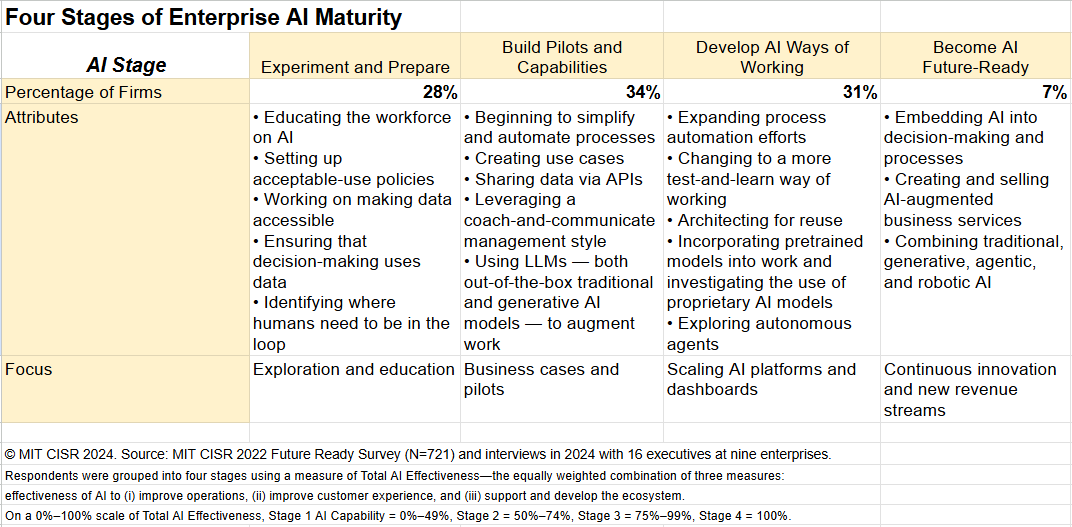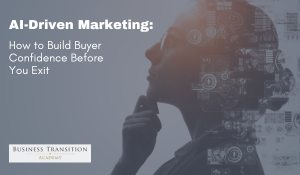If you’re preparing your business for sale, your marketing operations function is likely one of the...
New Research from MIT: How to Boost Your Organization’s AI Maturity Level
Part of our Future-Proof Your Exit series on building smarter, more efficient businesses
Many organizations are experimenting with AI—but few have crossed the chasm from pilot projects to enterprise-scale results. According to new research from the MIT Center for Information Systems Research (CISR), the greatest financial performance gains come not from experimenting with AI—but from mastering it. Organizations that are AI mature outperform early-stage AI implementers—but many companies struggle to advance from AI pilots to AI at scale. Let’s take a look.
Organizations advance through four stages of AI maturity, each representing a deeper integration of AI into business operations, according to the authors.
- In the first stage, Experiment and Prepare, companies focus on exploration—educating teams, setting policies, and making data accessible.
- The second stage, Build Pilots and Capabilities, involves developing use cases, simplifying processes, and testing AI tools like large language models to augment work.
- In stage three, Develop AI Ways of Working, businesses begin scaling automation, reusing architectures, and embedding AI into workflows through experimentation and agile methods.
- Finally, in stage four, Become AI Future-Ready, AI becomes central to decision-making, innovation, and new revenue streams—combining traditional, generative, and agentic AI to drive continuous improvement and competitive advantage.

From Pilots to Scale: The Four Levers of AI Maturity
MIT CISR identifies four factors that help companies advance their AI maturity—and outperform competitors who remain stuck in early experimentation:
- Strategy: Align AI investments directly with strategic goals and measurable business value.
- Systems: Build modular, interoperable data platforms that support enterprise-wide intelligence.
- Synchronization: Redesign work and roles for an AI-enabled organization, creating AI-ready teams.
- Stewardship: Embed transparent, compliant, human-centered AI practices from the start.
Lessons from Leaders: Guardian and Italgas
Two companies demonstrate what scaling AI maturity looks like in action:
- Guardian Life Insurance streamlined its quoting process—from one week to just 24 hours—by aligning AI pilots to business goals, modernizing legacy systems, and investing in workforce reskilling.
- Italgas, Europe’s largest natural gas distributor, embedded AI across infrastructure management and operations—boosting project speed by 40% and reducing inspections by 80%—supported by an innovation hub and 30,000 hours of AI training.
AI Maturity Is an Organizational Transformation
Moving from AI pilots to scalable impact requires more than technology—it demands leadership alignment, cultural readiness, and governance. The most successful organizations bring together the CEO, CIO, strategy, and HR leaders to drive coordinated change.
“Now is the time for executive teams to align, commit, and lead the charge toward enterprise-scale AI,” the researchers conclude.
Future-Proof Your Exit
This piece continues our look at how organizations can make practical progress with AI—focusing on small, measurable steps that build confidence and capability over time. Advancing AI maturity means creating a culture of efficiency, innovation, and readiness for whatever comes next.
Whether you’re a business owner preparing for an exit or a leader positioning your organization for growth, advancing your AI maturity signals efficiency, innovation, and readiness to buyers and investors alike.
Missed a Post? Catch Up on the Full Future-Proof Your Exit Series:
- AI, Automation & Exit Value: What Tech Readiness Means for Your Business
- 6 Steps to Start Using AI Across Your Business Before You Sell
- 6 Tips for Helping Your Team Embrace AI Without Resistance
- Smarter Selling with AI: How Sales Teams Can Use AI to Drive Growth—and Business Value
- AI-Driven Marketing: How to Build Buyer Confidence Before You Exit
- 8 Simple AI Wins That Impress Buyers (Without Overhauling Your Business)



